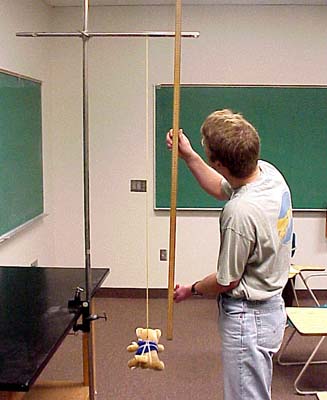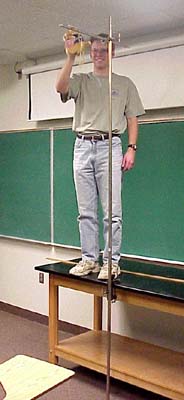
Video clips showing how this demonstration is used in class: clip 1 | clip 2 | clip 3
Our bungee jumper is Cosmo, a stuffed cougar mascot of Brigham Young University (see figure below). We cut him open and added about two pounds of extra weight to his bottom. We made a harness for him. The bungee cord is surgical tubing, about 1/8 inch in outer diameter.

We first determine the "spring constant" k of the bungee cord. Cosmo's mass is m = 1.13 kg. The unstretched length of the bungee cord is L = 0.52 m. When we hang Cosmo by the bungee cord, letting him come to rest, we find that the stretched length of the bungee cord is 1.25 m, an increase of x = 0.73 m (see figure below).
We calculate the spring constant of the bungee cord:
k = F/x = mg/x = 15.2 N/m.

If we release Cosmo at the position where the other end of the bungee cord is attached, he falls until the force of the stretched cord finally stops him at the bottom of his fall. This is a good illustration of how mechanical energy is transformed from one form to another. When Cosmo is released, he has gravitational potential energy. As he falls, the gravitational potential energy is converted into kinetic energy. When he reaches the point where the bungee cord begins to stretch, gravitational potential energy begins to be converted into the potential energy of the cord. Eventually, all of the kinetic energy is also converted into potential energy of the cord, and Cosmo comes to rest (momentarily). Below is a plot of different forms of energy as a function of the distance Cosmo has fallen.
You may shift click on this image to download a pdf file from which a transparency of this image can be made.
How far will Cosmo fall if we release him at the position where the other end of the bungee cord is attached? We use conservation of mechanical energy to solve this problem.
Kinetic energy: At the point of release, Cosmo is at rest, so the initial kinetic energy is zero. Also at the bottom of his fall, he will be momentarily at rest, so the final kinetic energy is also zero.
Potential energy due to gravity: Let h be the distance Cosmo falls. The gravitational potential energy of an object is given by mgy, where y is the vertical height. If we let y = 0 at the bottom of the fall, then y = h at Cosmo's initial position. Thus, the initial gravitational potential energy is mgh, and its final value is zero.
Potential energy of the bungee cord: The potential energy of the bungee cord is (1/2)kx2, where x is the amount by which the cord is stretched. At Cosmo's initial position, the bungee cord is not stretched, so the initial potential energy of the cord is zero. At the bottom of the fall, the cord is stretched by an amount h-L where L is its unstretched length. The cord does not begin to stretch until Cosmo has fallen a distance L. Thus, the final potential energy of the bungee cord is (1/2)k(h-L)2.
Conservation of mechanical energy: If we neglect any losses due to nonconservative forces such as air resistance and friction, then we can use conservation of mechanical energy to solve this problem, i.e., the initial mechanical energy is equal to the final mechanical energy:
mgh = (1/2)k(h-L)2.
The left hand side of the equation is the initial energy, Cosmo's gravitational potential energy. The right hand side of the equation is the final energy, the potential energy of the bungee cord when it is fully stretched. Gravitational potential energy has been converted into potential energy of the bungee cord.
This equation is quadratic in h. When we solve for h, we obtain two values, 0.11 m and 2.39 m. We reject the first solution since we know that Cosmo must fall at least 0.52 m, the unstretched length of the bungee cord. (The solution, h = 0.11 m, was obtained because the expression (1/2)k(h-L)2 allows the cord to have potential energy when h is less than L, when in fact its potential energy is then zero.)
We thus obtain the solution h = 2.39 m which is almost 8 feet. We adjust the height of a support rod (see figure) so that it is about 2.6 m above the floor (allowing for the distance between Cosmo's feet and the position where the bungee cord is attached to Cosmo's harness, and also adding a few more cm so that Cosmo comes to within a few cm of the floor at the bottom of his fall). We attach the end of the bungee cord to the rod, hold Cosmo so that the position where the cord is attached to his harness is at the same height as the rod, and then release him. If no errors were made in the measurements or the calculations, Cosmo will fall to within a few cm of the floor.
